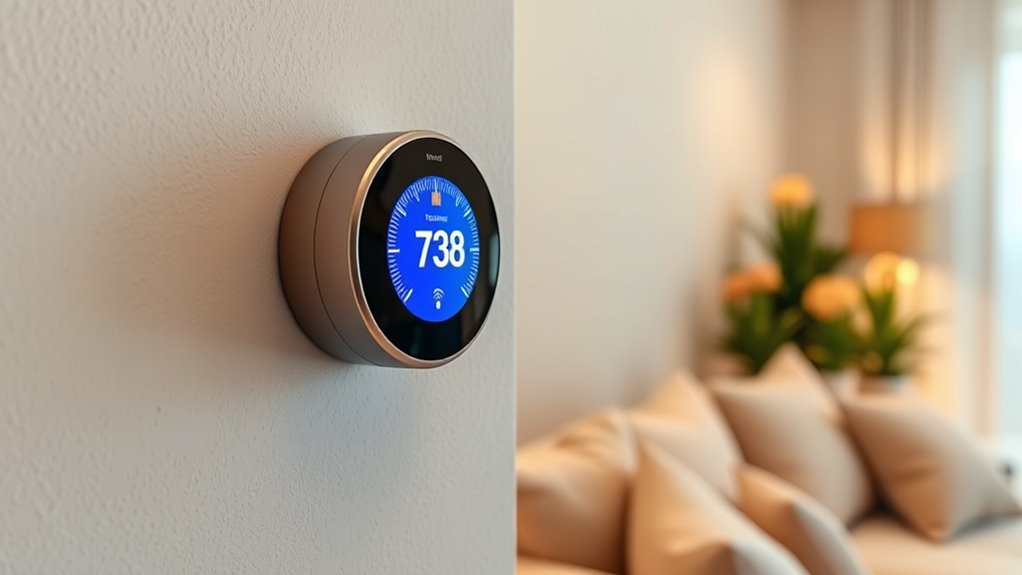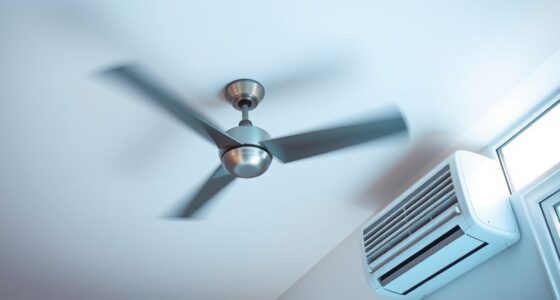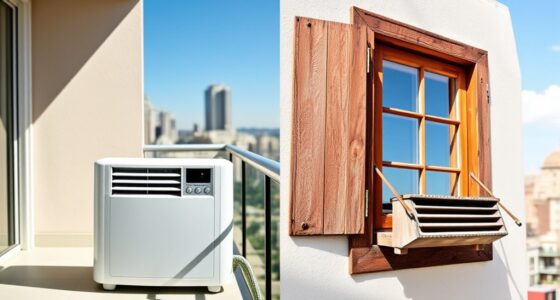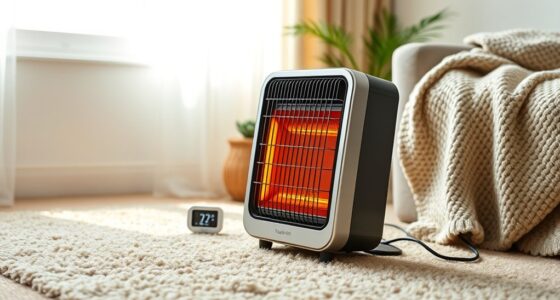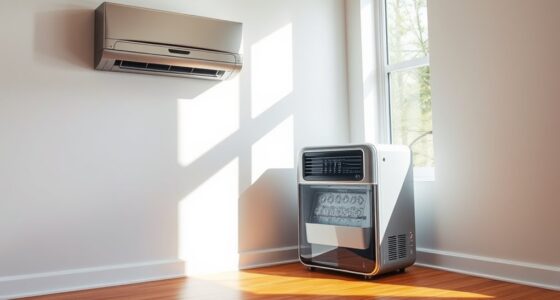To optimize your smart thermostat for comfort, set a consistent schedule that matches your daily routines. Use temperature ranges around 68°F during the day and lower it at night for savings, or keep it around 78°F in summer when you’re home. Enable learning features that adapt to your habits and connect your device with sensors for greater efficiency. Keep exploring to discover how fine-tuning these settings can make a real difference in comfort and energy savings.
Key Takeaways
- Create personalized schedules aligning heating and cooling with daily routines for consistent comfort and energy savings.
- Use smart learning features to automatically adapt temperatures based on your habits over time.
- Set appropriate temperature ranges, like 68°F in winter and 78°F in summer, to balance comfort and efficiency.
- Integrate your thermostat with occupancy sensors and window detectors to optimize energy use when rooms are empty.
- Regularly adjust and fine-tune settings remotely via smartphone apps for continuous comfort management.
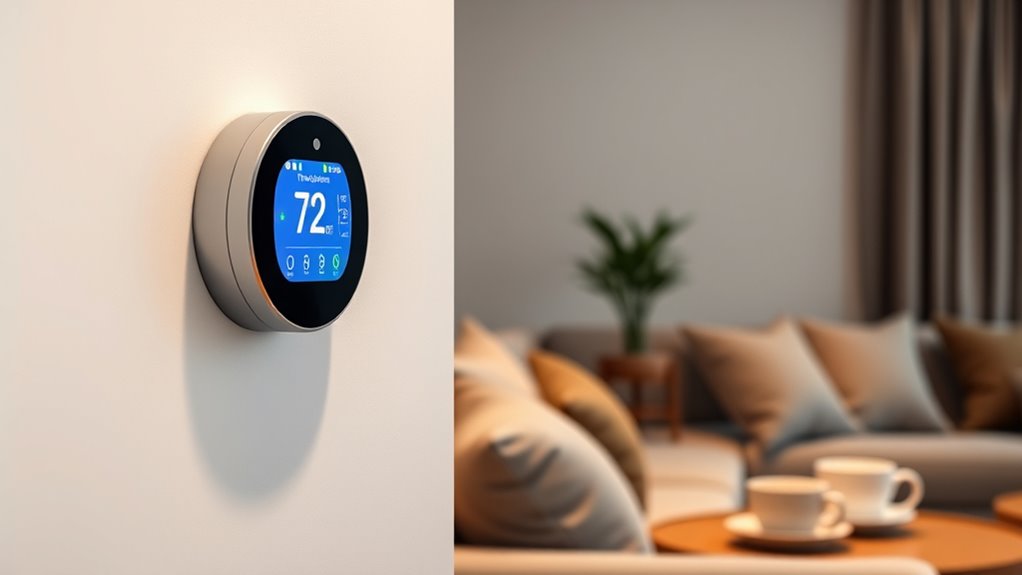
Adjusting your smart thermostat settings can substantially improve your home’s comfort and energy efficiency. When you take the time to fine-tune your device, you not only create a more pleasant living environment but also maximize energy savings. Modern smart thermostats are designed with user customization in mind, giving you the flexibility to set schedules, preferences, and even adapt to your routines automatically. This level of control allows you to avoid wasting energy on heating or cooling when you’re not home or when you don’t need it, which directly impacts your utility bills.
Start by analyzing your daily routine. Most smart thermostats let you create personalized schedules that align with your lifestyle. For example, you can set your home to be cooler during work hours and warmer just before you return. This ensures you’re not heating or cooling an empty house, saving energy without sacrificing comfort. Additionally, many models allow you to adjust settings remotely via smartphone apps, giving you the power to change temperatures if your plans shift unexpectedly. This user customization ensures you’re always in control, avoiding unnecessary energy consumption and keeping your environment comfortable at all times.
Create personalized schedules and remotely adjust settings for optimal comfort and energy savings.
Another tip is to take advantage of smart features like learning algorithms. Some thermostats automatically adapt to your habits over time, reducing the need for manual adjustments. As you interact with your device, it learns your preferred temperatures and schedules, fine-tuning itself to optimize energy savings. This intelligent adjustment not only simplifies your routine but also ensures your home stays comfortable while minimizing energy waste. By leveraging these features, you create a tailored environment that responds to your lifestyle, rather than forcing you to adapt to rigid settings. Incorporating vegetable juices into your routine can also support your overall health, helping you stay energized and focused to manage your home efficiently.
You should also consider setting temperature ranges that balance comfort and efficiency. For instance, during winter, keeping your thermostat at a consistent 68°F during the day and lowering it at night can reduce energy use without sacrificing comfort. In summer, maintaining a temperature around 78°F when you’re home helps keep cool without excessive energy drain. These small adjustments, based on your specific needs and preferences, can lead to significant energy savings over time. User customization makes it easy to experiment and find the perfect balance that works for you.
Finally, don’t overlook the importance of integrating your smart thermostat with other smart home devices. Connecting it with window sensors or occupancy detectors can further optimize settings, turning heating or cooling off when rooms are empty. These integrations enhance user customization and help you save even more energy. By actively managing your thermostat settings and utilizing its smart features, you ensure your home remains comfortable while keeping energy consumption in check, ultimately leading to lower bills and a more sustainable lifestyle.
Frequently Asked Questions
How Often Should I Update My Smart Thermostat’s Firmware?
You should check your smart thermostat’s firmware updates regularly, ideally every few months, to guarantee it runs smoothly and securely. Firmware updates are crucial for bug fixes, new features, and security patches. Follow your device’s maintenance schedule, and enable automatic updates if available, so you don’t miss essential improvements. Staying on top of firmware updates keeps your thermostat functioning at its best and helps prevent potential issues.
Can Smart Thermostats Detect and Respond to Indoor Air Quality?
Your smart thermostat can detect and respond to indoor air quality by monitoring sensors that track air quality and indoor air conditions. When it senses poor air quality, it can adjust settings like ventilation or activate air purifiers to improve indoor air and air quality. This helps create a healthier environment, ensuring that your indoor air remains fresh and safe, all while maintaining ideal comfort levels effortlessly.
Are There Energy-Saving Tips Specific to Smart Thermostat Usage?
Think of your thermostat as a wise conductor guiding your home’s energy symphony. To save energy, you should implement energy-efficient scheduling, adjusting temperatures during peak and off-peak hours. Utilize temperature zoning to target specific areas, avoiding waste. These strategies let your smart thermostat work like a savvy navigator, steering your energy use smoothly and efficiently, so you stay comfortable without draining your wallet.
How Do I Troubleshoot Connectivity Issues With My Smart Thermostat?
When troubleshooting connectivity issues, first check your Wi-Fi signal strength to make sure it’s strong enough for your thermostat. If problems persist, try a network reset by turning off your router and thermostat, then turning them back on. Also, verify your thermostat is within range of your Wi-Fi. Updating firmware and re-entering Wi-Fi credentials can also help restore a stable connection, ensuring your smart thermostat works seamlessly.
Can Smart Thermostats Be Integrated With Home Security Systems?
You can definitely integrate your smart thermostat with your home security system to enhance home automation and energy management. Many systems allow seamless connectivity, letting you control temperature settings alongside security features. This integration helps you optimize energy use, improve safety, and automate routines like adjusting the thermostat when you arm or disarm your security system. Check compatibility with your devices and use the app or hub to set up these smart integrations easily.
Conclusion
By fine-tuning your smart thermostat settings, you gently guide your home toward cozy comfort without overdoing it. With just a few thoughtful adjustments, you create an inviting atmosphere that feels just right—no fuss, no excess. Embrace the subtle art of temperature control, and your space will always feel welcoming. After all, a little balance goes a long way in making your home the perfect retreat, quietly and effortlessly.
